Protection Zones
The whole power system must be protected. This is achieved by dividing it into overlapping zones. If a fault occurs in a particular zone, only the protection system covering that zone should operate. Those systems relating to other zones should not operate.

In some cases, adjacent zones may operate after a preset time-delay, to provide back up.
A protected zone is that portion of a power system protected by a given protection system or part of that protection system. Any fault occurring within a zone will cause circuit breakers in that zone to operate and trip.
Generally, there are two types of protection concepts: unit and non-unit protection. This technical article explains the first one – unit protection concept.
Contents:
Introduction to Unit Protection
The boundary of operation is clearly defined in terms of primary plant. Unit protection is designed to operate for abnormal conditions inside the protected zone while remaining stable for abnormal conditions outside the protected zone.
This scheme requires current to be measured at each end of the zone. Figure 1 shows a simple unit protection scheme, while Figure 2 shows only one phase of the scheme.


Unit protection is very simple in concept. Figure 2a shows the current transformer flows produced by a fault outside the unit protection zone. The current through the relay is zero if the two current transformers are identical.
Figure 2b shows the situation for an internal fault. In this case, the current through the relay is not zero.


The unit protection scheme is inexpensive, fast acting and very stable. This ideal protection is used extensively for:
- Transformers
- Busbars
- Reactors
- Capacitors
- Lines, and
- Generators.
A number of unit protection arrangements are examined here: transformer, line protection using pilot cable (balanced voltage and circulating current), phase comparison carrier and digital differential protection.
1. Transformer Unit Protection
A typical auto transformer unit protection scheme is shown in Figure 3. Each phase winding forms a three ended protected zone and the current
transformers in the low and high voltage and neutral ends of the windings are connected in parallel to form a circulating current scheme.
The stabilizing resistor ensures that the relay does not operate for faults outside the protected zone during the first few cycles when the current transformers may not faithfully transform the primary current.
The voltage limiting device prevents the relay from being damaged by the very large voltages which could occur due to the large current which would flow in it and the stabilizing resistor when a fault occurs in the protected zone.
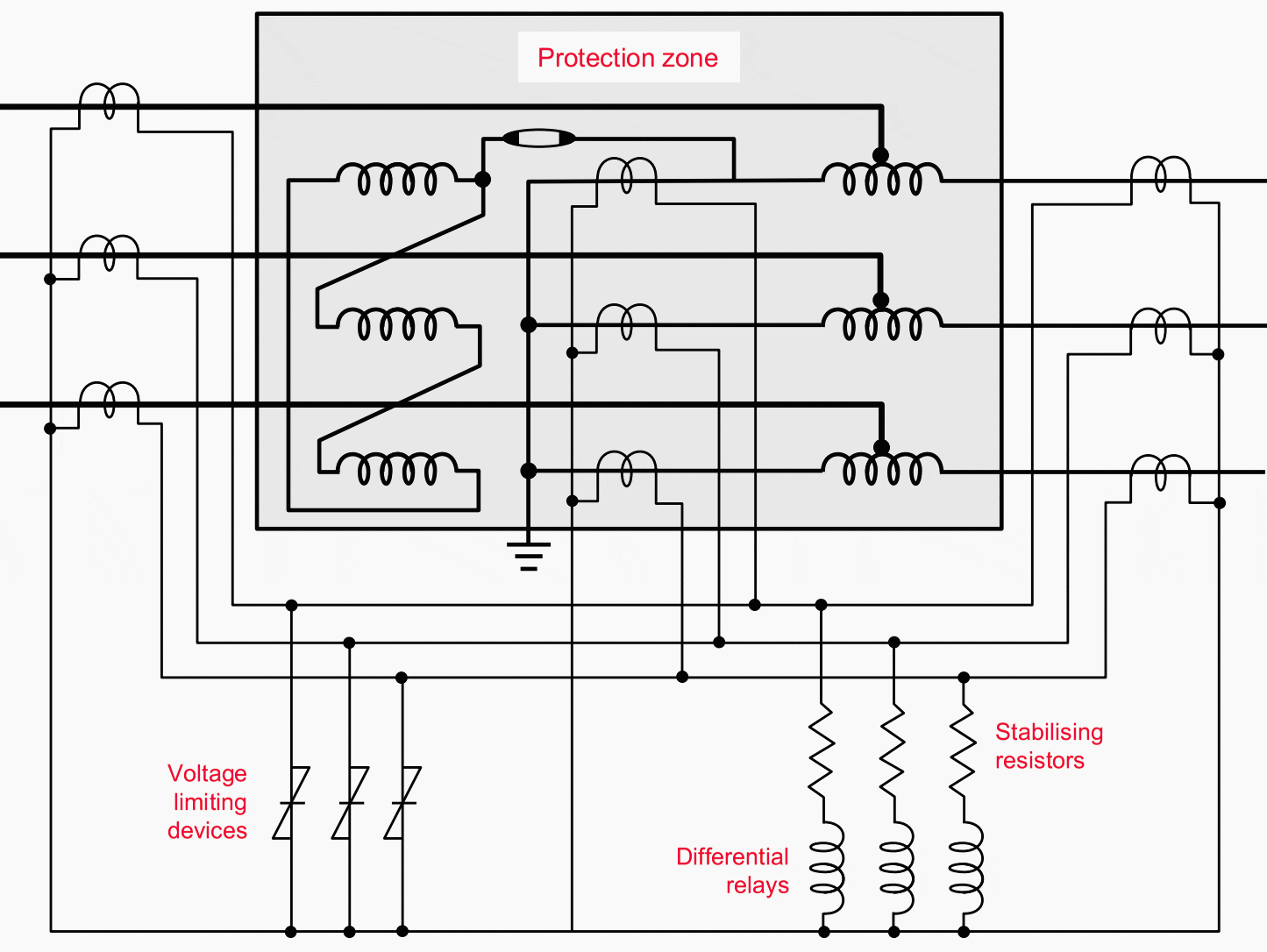

2. Pilot Unit Protection
Unit protection schemes are also used for overhead lines and underground cables, with these schemes it is more convenient to have relays at each end of the line connected by pilot cable.
Two basic arrangements are used for pilot unit protection:
- Balanced voltage (see Figure 4), and
- Circulating current (see Figure 5).
2.1 Balanced Voltage
In Figure 4 the pilot voltages balance each other for an external fault. Most of the current flows through the restrain (bias) coil rather than the operating coil.
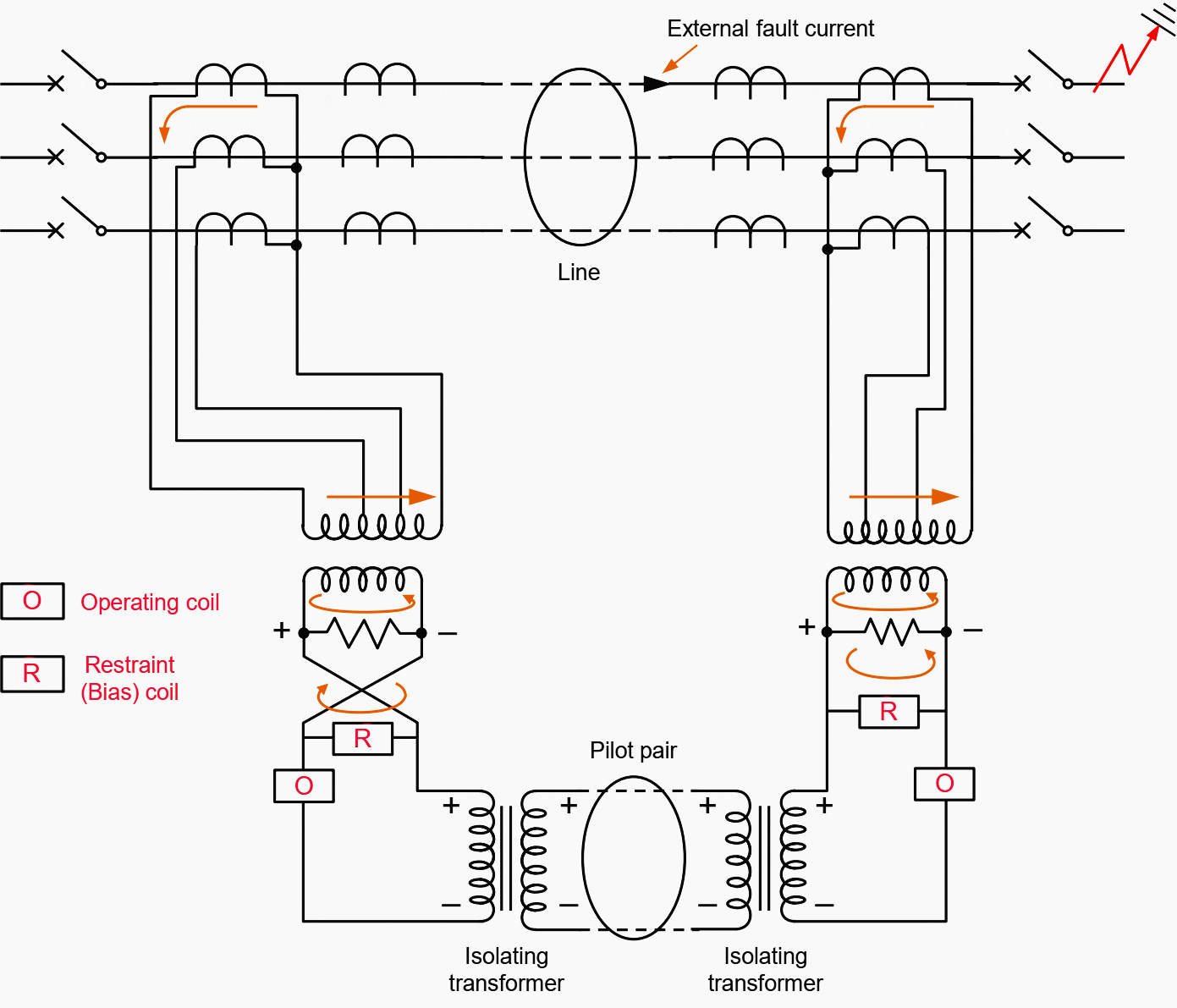

The number of such schemes still to be found in service – for new installations it has been almost completely superseded by circulating current schemes.
It is the dual of the circulating current protection. With primary through current, the secondary e.m.f.s of the current transformers are opposed, and provide no current in the interconnecting pilot leads or the series connected relays.
An in-zone fault leads to a circulating current condition in the CT secondaries and hence to relay operation.
To avoid excessive saturation of the core and secondary waveform distortion, the core is provided with nonmagnetic gaps sufficient to absorb the whole primary m.m.f. at the maximum current level, the flux density remaining within the linear range.
The secondary winding therefore develops an e.m.f. and can be regarded as a voltage source. The shunt reactance of the transformer is relatively low, so the device acts as a transformer loaded with a reactive shunt; hence the name of transactor.
The equivalent circuit of the system is as shown in Figure 5.
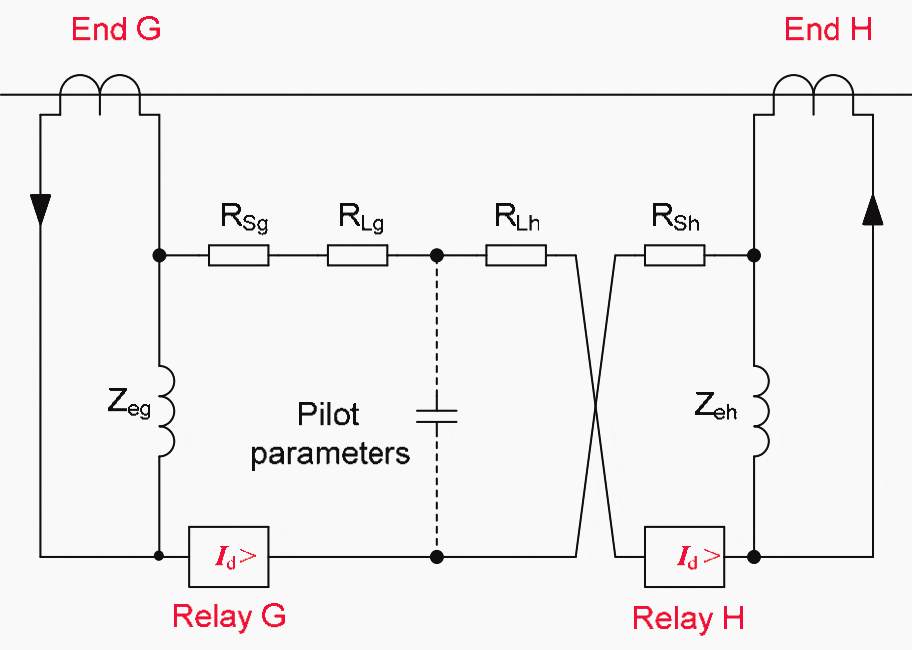

The series connected relays are of relatively high impedance, because of this the CT secondary winding resistances are not of great significance and the pilot resistance can be moderately large without significantly affecting the operation of the system.
This is why the scheme was developed for feeder protection.
Stability Limit of the Voltage Balance System
Unlike normal current transformers, transactors are not subject to errors caused by the progressive build-up of exciting current, because the whole of the primary current is expended as exciting current.
A broken line in the equivalent circuit shown in Figure 5 indicates such capacitance. Under through-fault conditions the pilots are energized to a proportionate voltage, the charging current flowing through the relays.
The stability ratio that can be achieved with this system is only moderate and a bias technique is used to overcome the problem.
2.2 Circulating Current
In Figure 6 the pilot currents add at each end to produce a circulating current for an external fault. The majority of current again flows through the restraint coil.
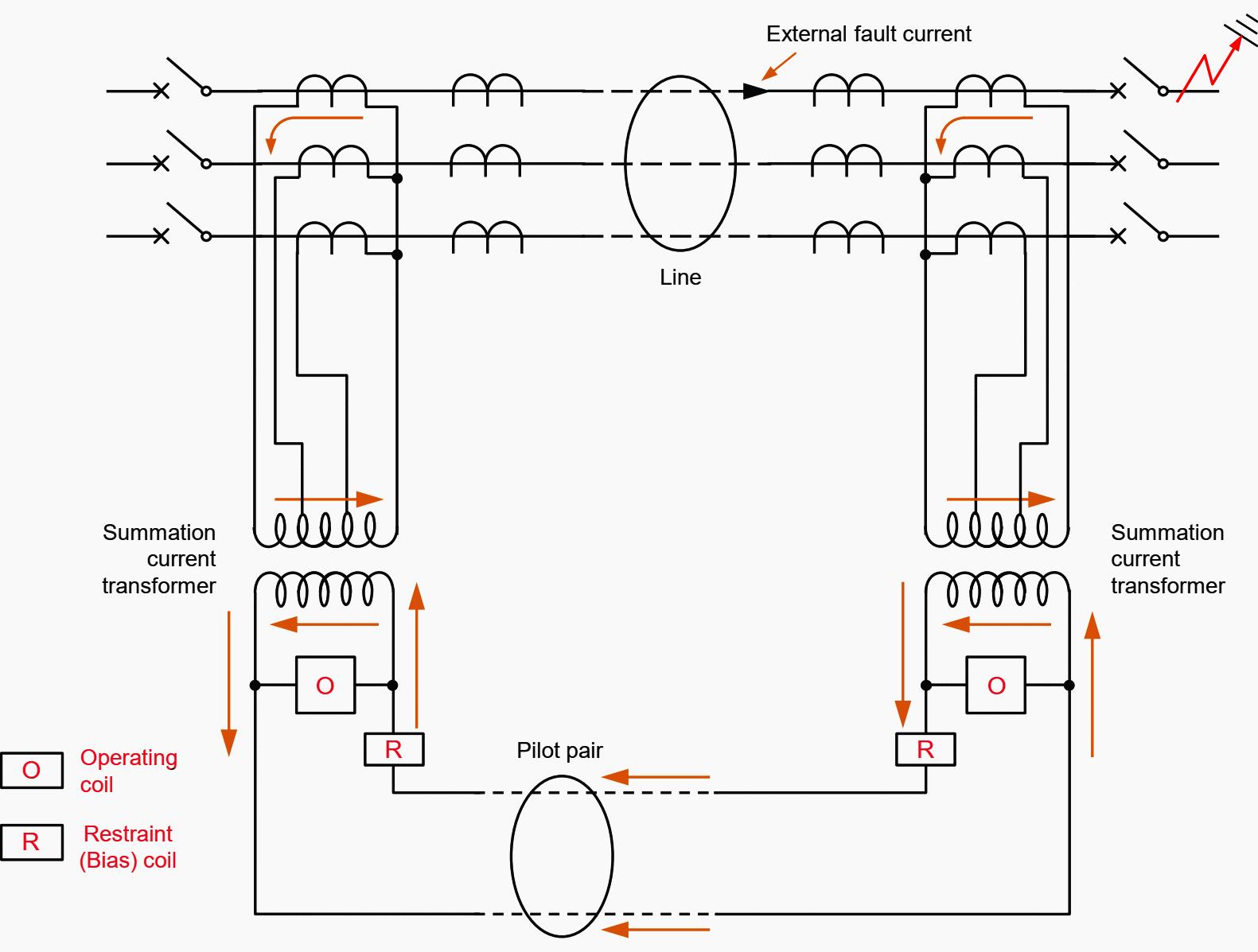

When the balancing current transformers of a unit protection system differ in excitation characteristics, or have unequal burdens, the transient flux build-ups will differ and an increased ‘spill’ current will result.
There is a consequent risk of relay operation on a healthy circuit under transient conditions, which is clearly unacceptable.
When a stabilizing resistor is used, the relay current setting can be reduced to any practical value, the relay now being a voltage-measuring device. There is obviously a lower limit, below which the relay element does not have the sensitivity to pick up.
Problems…
A problem with these two different arrangements (balance voltage and circulating current schemes) is that damage to the pilot cable may result in the following:
- Open circuit of pilot cable – the circuit could trip in the circulating current arrangement for through faults or high load current
- Short circuit of pilot cable – the circuit could trip in the balanced voltage arrangement. This problem is summarised in Table 1.
Table 1 – Potential problems
| Protection Type | Pilot Cable Open Circuited | Pilot Cable Short Circuited |
| Circulating Current | Trip | Inoperative |
| Balanced Voltage | Inoperative | Trip |
Typical pilot protection scheme


3. Digital Differential Unit Protection
Digital differential line protection relays at each end of the line determines digital values to represent the current flowing at that point on the line.
These digital values are communicated to the relay at the opposite end for comparison.
Where the local and remote digital values are the same indicates a healthy power line, however where the digital values differ this would indicate a fault and the circuit breakers at each end are tripped by the local relay.
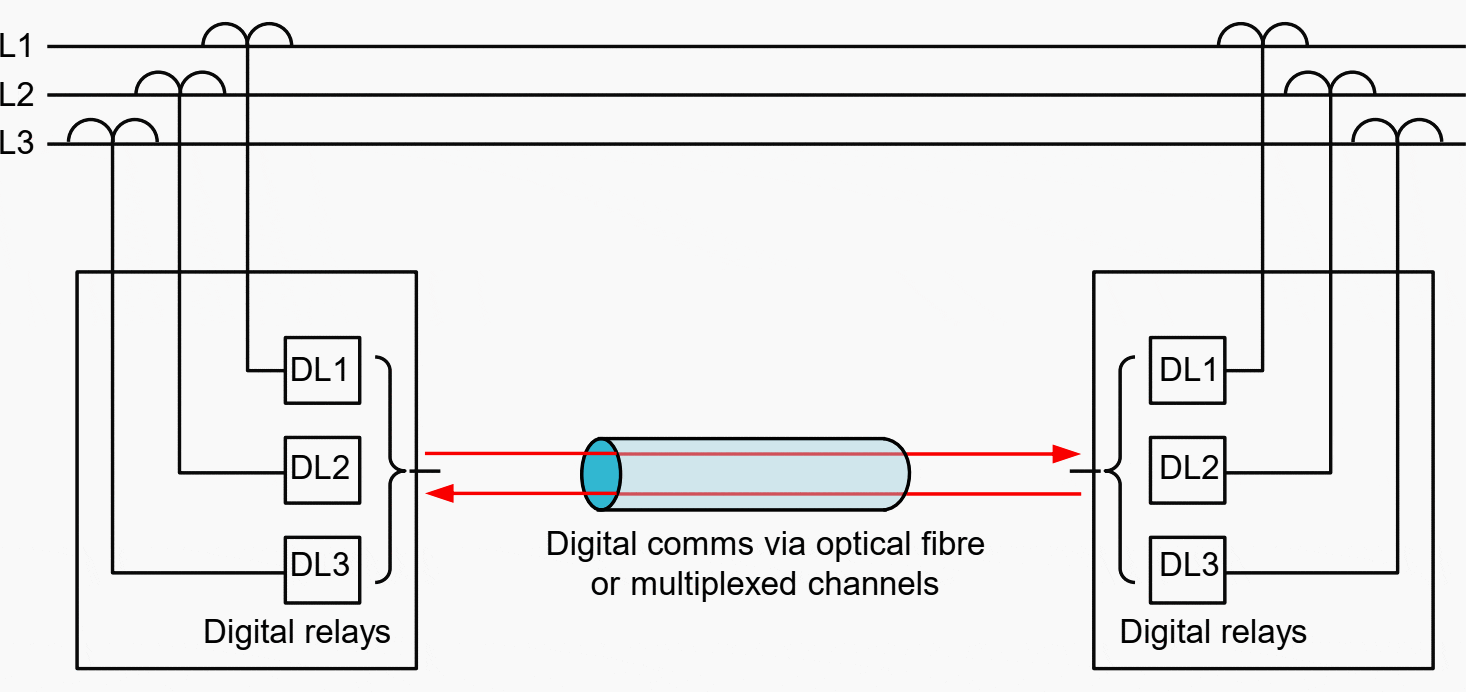

4. Phase Comparison Carrier
Another form of unit protection is phase comparison carrier protection in which the phase angle of the current at each end of the line is compared. The communications channel is the line itself. A high frequency signal is injected across two phases of the transmission circuit at one end and received at the other.
The arrangements for signal injection are shown in Figure 9.
With this arrangement at each end, the signal is restricted to the line and cannot pass into other circuits.
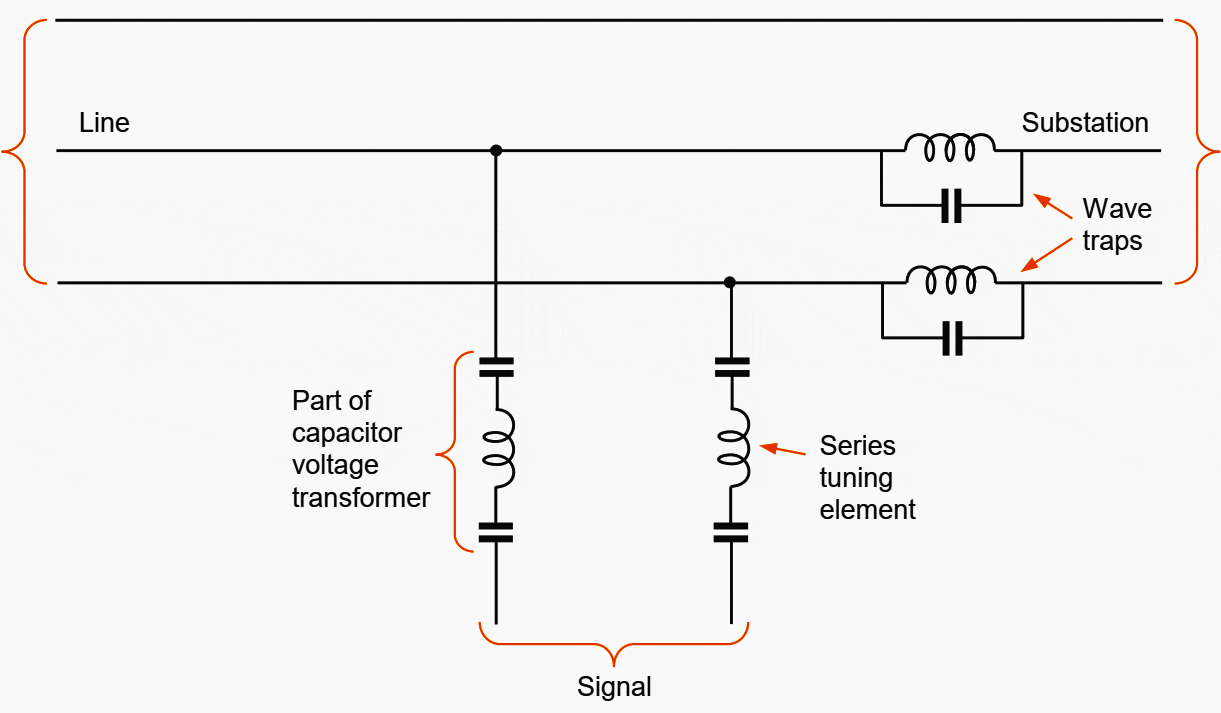

A simplified carrier protection arrangement is shown in Figure 10.
The transmitted and received signal blocks are approximately 180 degrees out of phase. This is due to the End A and End B apparatus being identical while the primary current is being exported at one end and imported at the other.
The blocks of signal would be in phase with End A. When superimposed, gaps of approximately 180 degrees are left.


These gaps initiate tripping. The angle of gaps (for which tripping occurs) varies, a 30 degree setting being typical. The time to trip is in the order of 3 to 4 cycles.
Such conditions prompt only the comparison of ends. The equipment stabilizes if the conditions are due to a through fault.
Usually, carrier protection arrangements have a self-testing feature, for example, a clock starting every 30 minutes or 12 hours, depending on the type of protection. If one end of a carrier system fails and locks out, the system becomes unstable for through faults or high currents.
Sources:
- Switching Operator’s Manual Transmission Switching by Horizon Power
- Network Protection and Application Guide, Protective Relays, Measurement and Control by Alstom Grid











Nice article. Please can I get a copy of the pdfs.
Excellent demonstrating diagram and text. Still on study. If found any improvement will be fed back soon